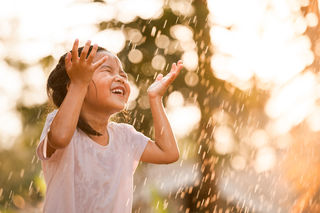Gratitude
How to Teach Children to Practice Gratitude
It is a key to developing emotional resilience.
Posted May 6, 2020 Reviewed by Ekua Hagan

There’s a lot we don’t know about the novel coronavirus and how this pandemic will play out. This uncertainty creates anxiety and depression for many of us. My play therapy with children, as well as observations within my own family, informs me that our children feel it, too. But there are things we can start doing today that will help our children—and us—feel better. One is to practice gratitude, or thankfulness.
Gratitude helps us cope in times of crisis
Gratitude, which we feel when we count our blessings and pay attention to what we have—versus what we don’t have—is linked to many positive benefits, including:
- Feeling happy
- Being optimistic
- Experiencing greater life satisfaction
- Becoming emotionally resilient
- Enjoying better physical and mental health
Research shows that when we shift our attention from negative, toxic emotions to positive ones, we experience a greater sense of well-being.
It’s still important to acknowledge negative feelings
I’m not suggesting that we deny our children’s fear, loss, anger, or trauma. It’s crucial for children to express their negative emotions.
In fact, children often can’t let go of negative feelings until they’ve been acknowledged by and processed with another. But once validated, it’s important to help children shift their focus to other more pleasurable experiences and memories.
Being grateful takes effort
Practicing gratitude can take some work, especially at times when we are overloaded with stress in times of crisis. But even when we don’t exactly feel grateful, we can still think about what we have and be grateful for it.
One way to do this is to take time at least once a week to focus our attention on some of the good things we feel grateful for. These can range from big things, such as being healthy, to smaller, more momentary experiences, such as the cool fort the family built in the living room, a Zoom reunion, or a walk outside.
The benefits of gratitude can take a few weeks to develop, but once established, they have lasting effects on the brain and on mental health overall.
Building grateful habits
Here are some simple activities we can do with our children to cultivate gratitude.
- Have them write letters/cards/emails to express their gratitude to important people in their lives.
- Encourage them to reminisce about pleasurable shared moments—a fun game of hide-and-seek or the delicious homemade chocolate chip cookies.
- Have each individual family member identify three reasons they are grateful for every other family member.
- Take turns naming five things each are grateful for that week during Sunday dinner.
Keep in mind: It is most important for children to witness their parents modeling gratitude.
The “Good Things” Jar
Several years ago, on New Year’s Day, our family made a “Good Things” Jar. Throughout the year we would write on small pieces of paper the good things we experienced, and placed them in the jar. Each subsequent New Year’s Day, we would empty the jar and read through all of the good things we recorded throughout the year—many of which had been forgotten.
Our “Good Things” Jar helped us remember our gratitude. These positive recollections lessened the negative impact of negative memories and helped build our emotional resilience—something we are sincerely grateful for as we head into an uncertain future.
By Jill Leibowitz, Psy.D.


